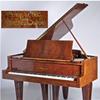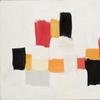FRANK AUERBACH: LONDON BUILDING SITES 1952–62
- LONDON, United Kingdom
- /
- November 10, 2009
This exhibition explores an extraordinary group of paintings of post-war London building sites by Frank Auerbach (born 1931), one of Britain’s greatest living artists. The series of fourteen major paintings was produced during the first decade of Auerbach’s career and gives a remarkable account of his early artistic development. It was during this period that Auerbach emerged alongside Francis Bacon and Lucian Freud as part of a powerful new generation of British painters. Frank Auerbach: London Building Sites 1952–62, on view at The Courtauld Gallery from 16 October 2009 to 17 January 2010, will give the first comprehensive account of these works, which are among the most profound responses made by any artist to the post-war urban landscape.
Auerbach’s years as a young art student in London, from 1947 to 1952, were spent in a city deeply scarred by the aftermath of the Second World War and at the beginning of a long period of recovery and rebuilding. The Blitz had levelled whole areas of London and left numerous buildings severely damaged or destroyed. This wounded landscape was punctuated by remarkable survivals, most famously St Paul’s Cathedral standing defiantly among the ruins. Another spectacular sight was the rebuilding effort which saw armies of workmen clearing the debris and excavating new foundations. Ubiquitous symbols of the rebuilding were the tower cranes which sprang up across the city in advance of the new steel-framed offices and blocks of flats which were to transform London’s urban landscape (fig. 10). For Auerbach, hungry to prove himself as a modern painter, the building sites of London made the most compelling of contemporary subjects. As he recalled recently, “London after the War was a marvellous landscape with precipice and mountains and crags, full of drama… and it seemed mad to waste the opportunity and not to take notice of the fact that there were these marvellous images… all around one”.
Towards the end of his studies at various London art schools including, most importantly, David Bomberg’s inspirational teaching at the Borough Polytechnic, Auerbach began voraciously sketching the city’s building sites, as did his close friend and fellow student, Leon Kossoff. There was, Auerbach says, “a sense of survivors scurrying among a ruined city… and a sort of curious freedom… I remember a feeling of camaraderie among the people in the street”. For Auerbach, the sense of survival must have seemed particularly profound. He had been sent to England from his home city, Berlin, shortly before his eighth birthday and the outbreak of war. Both of his Jewish parents were killed in the concentration camps and Auerbach made London his new home. He combed the city, filling his sketchbooks with details of particular sites, capturing the activities of workmen and machinery as they reshaped London’s bombsites into new structures. He recalls how he would enter a site “by inching along the planks, out over the excavation, just clinging on and dodging the wheelbarrows”. It was the early stages of a construction site that most excited Auerbach, before the building had fully emerged from the ground and there was still a sense of struggle between the formlessness of the raw earth being excavated and the beginnings of architectural order.
Auerbach’s first painting, in what would become a group of fourteen major works, was Summer Building Site, 1952, (fig. 1), a construction site on the Earl’s Court Road. It was a breakthrough work for the twenty-one year old artist and he considered it to be his first truly original picture. “I had done my own painting,” Auerbach recalled, “I didn’t know if I would ever be able to do it again, but at least I knew what it felt like.” The composition is an interplay between the structuring diagonal lines of ladders and scaffolding and the broad areas of earth and excavation, conveyed as almost uncontrollable masses of raw paint. One of his next paintings of a nearby site, Building Site Earl’s Court Road, 1953, (fig. 2), took these qualities to an even greater extreme. As he worked and reworked the composition, his paint surface became ever thicker as he strove to express what he describes as “the core” of his subject. The result is a painting more than an inch thick in places in which the sheer weight and density of paint threatens to collapse in on itself, obscuring the image completely.
These thick, encrusted surfaces would come to characterise the rest of the works in the group. All of them began with Auerbach making sketches on a particular building site (fig. 3). He would pin these drawings up on his studio wall and begin to paint from them. Each work was the result of many months labour in the studio and it was not uncommon for paintings to take up to a year to complete. Auerbach is clear that he did not set out to create such heavily worked paintings; their surfaces are simply the outcome of his epic struggle with paint as he strove to achieve the most vital expression of his subject matter. Such works pushed the boundaries of painting to an extreme that many commentators of the day found unsettling at his first solo show at the Beaux Arts Gallery in 1956. However, David Sylvester described the exhibition as “the most exciting and impressive first one-man show by an English painter since Francis Bacon’s in 1949”.
Auerbach’s subjects included many of the major construction sites of the period, such as the Time and Life Building on Bruton Street, the rebuilding around St Paul’s Cathedral (fig. 7) and the John Lewis building on Oxford Street. He made repeated visits to perhaps the most spectacular site of all: the Shell Building on the South Bank, London’s first ‘skyscraper’ built on the site of the 1951 Festival of Britain (figs. 9, 10 and 11). Its height necessitated dramatically deep excavations which Auerbach described as being like the “Grand Canyon”. His Shell Building Site from the Thames (fig. 4) is a particularly dramatic evocation of his experiences there. The composition is dominated by a crane from which a cable drops into a deep excavation which appears to radiate light from within. Rembrandt’s Deposition in the National Gallery was a source of inspiration for the work and the crane’s form faintly recalls that of a crucifix, further imbuing the image with the theme of death and resurrection, which perhaps lies at the heart of all Auerbach’s building site paintings.
Two exceptionally powerful paintings, Maples Demolition, 1960, and Rebuilding the Empire Cinema, 1962, (figs. 5 and 6), mark the end of Auerbach’s building site series. The works’ palettes of strong yellows and reds contrast with his earlier paintings in the group which were painted in earth tones, as they were the only colours he could afford in the large quantities he required. These two paintings epitomise how Auerbach vividly translates chasms of mud and shored-up earth, cranes, scaffolding and the workmen of the building sites into paintings which capture a powerful sense of the destruction and reconstruction inherent in the redevelopment of London’s bomb sites. His heavily worked, thick surfaces express the material character of the sites; a painted equivalent of the mountains of earth and rubble being excavated and reshaped across the city. His own labours with paint over many months approached the timescale of the buildings themselves. In certain cases the buildings had been erected and opened by the time Auerbach had completed his paintings of their foundations.
The exhibition brings together all fourteen of Auerbach’s building site paintings, drawing on public and private collections nationally and internationally. It also displays a selection of Auerbach’s few surviving pencil sketches (most of which he destroyed) together with oil studies to reveal the artist’s complex creative process. Research for the exhibition has been greatly enriched by interviews conducted with the artist especially for this project.
FACT SHEET
Exhibition title: Frank Auerbach: London Building Sites 1952–62
Dates: 16 October 2009 to 17 January 2010
Sponsors:
Supported by Marlborough Fine Art (London) Ltd., the Friends of The Courtauld, the Rothschild Foundation and others who wish to remain anonymous.
Location:
The Courtauld Gallery, Somerset House, Strand, London WC2R 0RN
Tel. +44 (0)20 7848 2526, fax. +44 (0)20 7848 2589
www.courtauld.ac.uk
Opening hours:
Daily 10 am to 6 pm, last admission 5.30 pm
24 December 10 am to 4 pm; 25 & 26 December closed;
Late Night Openings: 22 October & 19 November until 9 pm (see below)
Admission:
Exhibition included in admission to permanent collection
Adult: £5.00, concessions: £4.00
Free admission: Mondays 10 am to 2 pm
Free at all times for under 18s, full-time UK students and unwaged
Catalogue:
The exhibition is accompanied by a fully illustrated catalogue edited by Barnaby Wright, with essays by Margaret Garlake, Paul Moorhouse and Barnaby Wright, published by Paul Holberton in association with The Courtauld Gallery, 128 pages, paperback, 260 x 216 mm, 60 colour illustrations, ISBN 978 1 903470 94 7, price £20.00.
A comprehensive monograph on Frank Auerbach by William Feaver has recently been published by Rizzoli New York, ISBN 978 0 8478 3058 9.
Gallery Events:
Curator’s Talks
21 October, 2 December and 6 January, 5.15 to 6 pm
Lunchtime Talks
23 October, 6 and 20 November, 4 and 18 December, 15 January,
1.15 to 1.30 pm
Sunday Tours
Every Sunday except 27 December, 3 to 3.45 pm
All the above are free with admission, no need to book.
Teachers’ Evening
29 October, 5.15 to 6.30 pm. Booking essential, contact joff.whitten@courtauld.ac.uk, tel. 020 7848 2705.
Film Screening
Frank Auerbach: To the Studio
11 November, 7 to 8.30 pm. Offering unique access to the artist’s studio, with an introduction by Jake Auerbach. Free, booking essential, contact joff.whitten@courtauld.ac.uk, tel 020 7848 2705.
Auerbach Lates
Thursday 22 October and 19 November, until 9 pm
Stay late and enjoy the exhibition. Throughout the evening a programme of gallery talks and live music will take place. There will also be fruity cocktails and delicious food available in The Courtauld Gallery Café.
Special 2 for 1 Lates Offer: Bring a friend for free from 6pm (second person free with the purchase of one full price admission ticket).
Study Day
Art in the Post-War World: Frank Auerbach and his Contemporaries
Saturday 5 December, 10 am to 3 pm
Cost £35 (concessions £30). Booking essential, tel. 020 7848 1058
For further information on exhibition events, please see
www.courtauld.ac.uk/gallery/auerbach
For further information on all Courtauld Public Education Programmes, contact education@courtauld.ac.uk or tel. 020 7848 1058.
Related Display: Building and Destruction: Architectural Imagery from The Courtauld Drawings Collection
This display explores artists’ enduring fascination with the life and death of buildings. It presents a rich selection of drawings and prints from various centuries and schools which take the construction, ruin and sometimes dramatic destruction of buildings as their subject matter.
How to get there: The Courtauld Gallery is situated in the North Building of Somerset House, which has entrances from the Strand and the Victoria Embankment. Mainline trains to Charing Cross, Waterloo or Blackfriars; underground stations Temple (District and Circle lines), Covent Garden (Piccadilly line) and Charing Cross (Northern, Bakerloo and Jubilee lines); buses 6, 9, 11, 13, 15, 23, 77a, 91 and 176 to Strand.
Access: The Gallery is wheelchair accessible, with level access to most areas and a lift to all floors. Assisted ramp access is available for Room 1.
24 hour access information line +44 (20) 7845 4671
Shop: The Courtauld Gallery Shop is open daily during Gallery hours, offering exhibition catalogues and a variety of merchandise inspired by the temporary exhibitions and the permanent collection. Tel. +44 (0)20 7848 2579, shop@sctenterprises.com
Café: The Courtauld Gallery Café is open daily from 10 am to 5.30 pm serving light meals and drinks.
For further information/images, please contact:
Sue Bond Public Relations
Tel. +44 (0)1359 271085
E-mail info@suebond.co.uk
Website. www.suebond.co.uk
30/10/2009
















